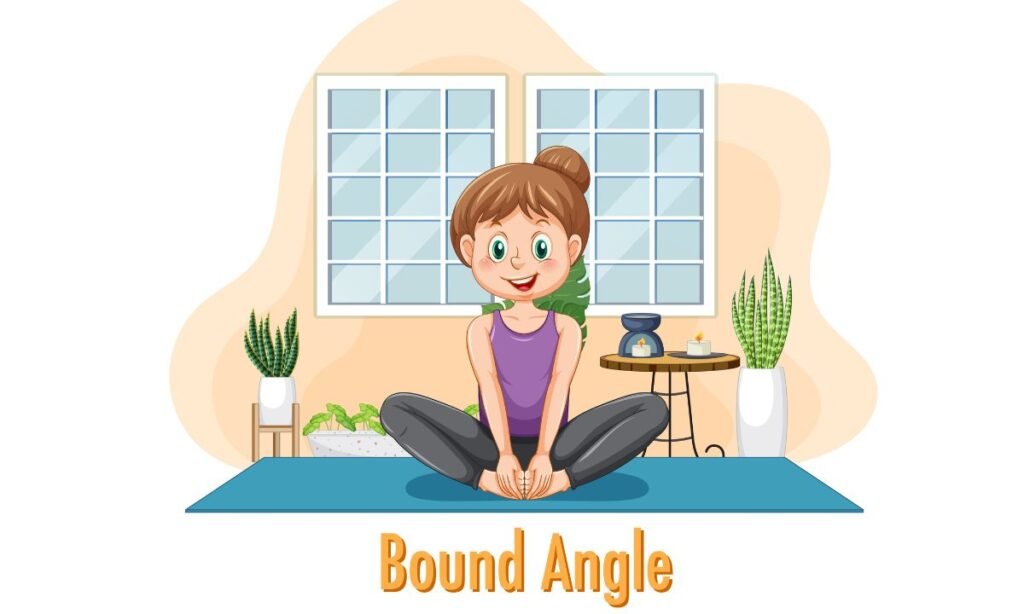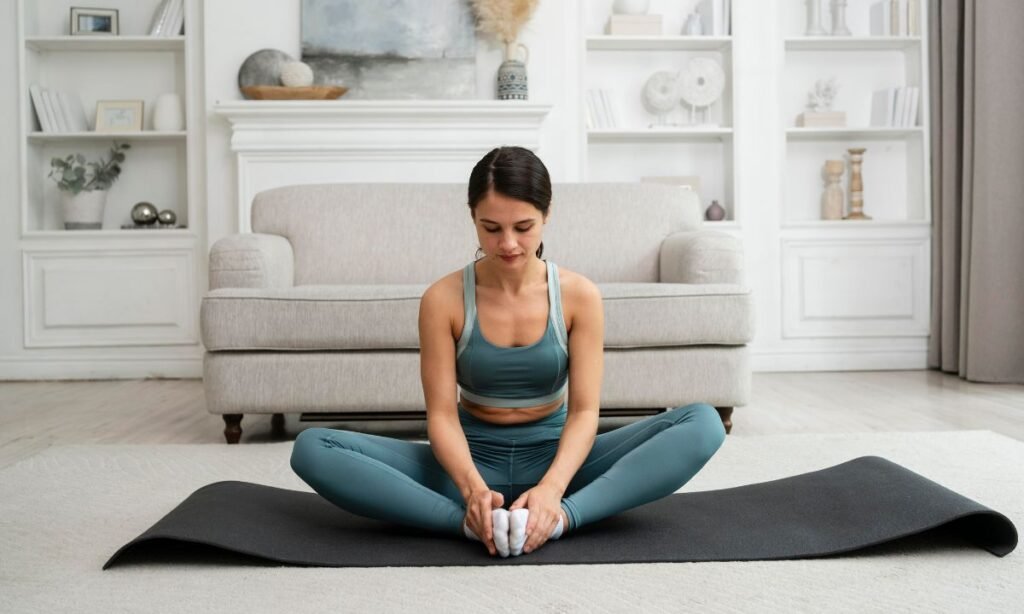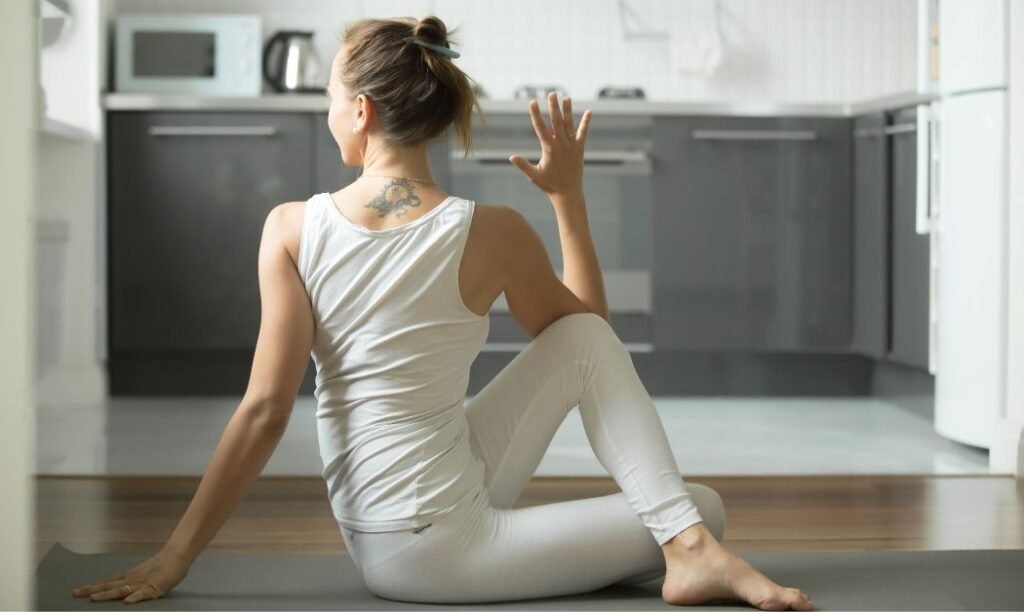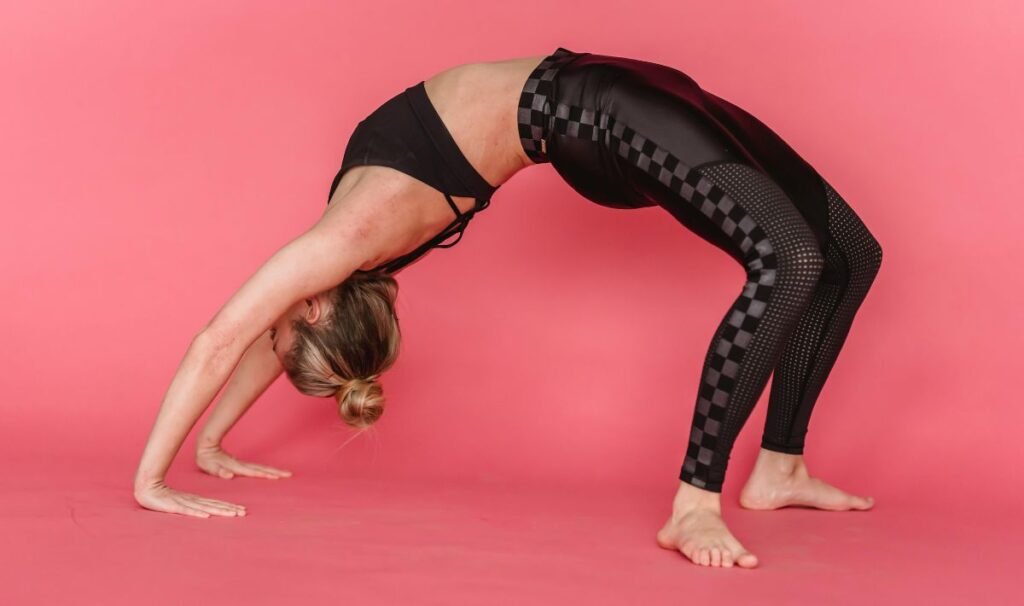Regarding yoga poses that relax your mind, stretch your body, and ground your spirit, the Bound Angle Pose, also known as Baddha Konasana, takes the crown. This gentle yet effective posture also called the Cobbler Pose, Butterfly Yoga Pose, or Butterfly Position, offers various physical and mental benefits, making it a staple in yoga routines worldwide.
Whether you’re a seasoned yogi or just starting your yoga journey, this pose is worth adding to your practice. In this blog, we’ll dive into everything you need to know about the Bound Angle Yoga Pose, its benefits, variations, and tips to get the most out of it.
What Is Bound Angle Pose (Baddha Konasana)?
The Bound Angle Pose, or Baddha Konasana, is a seated yoga posture where you sit with the soles of your feet pressed together while letting your knees drop toward the floor. Its name comes from Sanskrit:
- Baddha = Bound
- Kona = Angle
- Asana = Pose
It’s often referred to as the Butterfly Pose because your legs mimic a butterfly’s wings when you move them up and down gently. Another common name, Cobbler Pose, comes from its resemblance to the way cobblers sit while working.
This pose is a beautiful blend of simplicity and depth, offering both relaxation and a deep stretch in your inner thighs, hips, and groin area.
Why Practice Bound Angle Pose?
Baddha Konasana isn’t just about stretching your legs—it’s about finding balance, comfort, and mindfulness. Here’s why it’s a favorite among yogis:
1. Physical Benefits
- Increased Flexibility: This pose stretches the inner thighs, hips, and groin, improving overall lower body flexibility.
- Better Posture: It strengthens your back and spine, encouraging an upright sitting position.
- Hip Opener: A go-to pose for releasing tension in the hips, especially if you spend hours sitting at a desk.
- Boosts Circulation: Improves blood flow to the pelvic region, which can be beneficial for reproductive health.
2. Mental and Emotional Benefits
- Relieves Stress: The calming nature of this pose helps relax your mind and body.
- Encourages Mindfulness: Holding the pose with deep breathing cultivates present-moment awareness.
- Releases Emotional Tension: Tight hips often store emotional stress, and this pose can help release those pent-up feelings.
3. Holistic Benefits
- Digestive Health: By sitting upright and activating the pelvic region, this pose supports better digestion.
- Pregnancy-Friendly: It’s a favorite prenatal yoga pose as it gently stretches the pelvic area, preparing the body for childbirth.
Step-by-Step Guide: How to Do Bound Angle Pose

Follow these simple steps to practice Baddha Konasana with ease:
Step 1: Prepare Your Space
- Find a quiet, clutter-free area with enough room to stretch your legs.
- Use a yoga mat for comfort. You can add a folded blanket if needed for extra cushioning.
Step 2: Sit Down and Align
- Sit on your mat with your legs extended straight in front of you.
- Ensure your back is straight and your spine is elongated.
Step 3: Bend Your Knees
- Bend your knees and bring the soles of your feet together.
- Let your knees drop toward the floor like butterfly wings.
Step 4: Hold Your Feet
- Grab your feet or ankles with your hands. Keep your chest open and shoulders relaxed.
Step 5: Adjust and Breathe
- Sit tall with your spine straight. Avoid rounding your back.
- Inhale deeply as you lengthen your spine, and exhale as you let your knees sink closer to the floor.
Tips for Getting the Most Out of Bound Angle Pose
- Warm Up First: Loosen your body with light stretches or a short yoga flow to prepare your hips and thighs.
- Use Props: Place blocks or cushions under your knees if they’re far from the floor to avoid strain.
- Engage Your Core: Activating your core muscles can help stabilize your posture.
- Don’t Force It: Your knees don’t have to touch the floor. Focus on gradual progress.
- Add Movement: For a dynamic stretch, gently flutter your legs like a butterfly.
Mistakes to Avoid
1. Slouching
Slouching compromises the benefits of this pose. Always sit tall with your spine straight.
2. Overstretching
Don’t push your knees down forcefully. Yoga is about progress, not perfection.
3. Holding Your Breath
Breathe deeply to relax your muscles and deepen the stretch.
Bound Angle Pose Variations
1. Reclining Bound Angle Pose (Supta Baddha Konasana)
- Lie on your back with your feet together and knees open wide.
- Support your back with a bolster for a restorative experience.
2. Butterfly Pose with Forward Fold
- Lean forward from your hips, reaching your arms toward the floor.
- This intensifies the stretch in your hips and spine.
3. Supported Cobbler Pose
- Sit with your back against a wall for extra support.
- Perfect for beginners or those with tight hips.
Who Should Avoid Bound Angle Pose?
While Baddha Konasana is generally safe, avoid it if you:
- Have a hip or knee injury.
- Experience severe lower back pain.
- Are in the first trimester of pregnancy without proper guidance.
Incorporating Bound Angle Pose into Your Yoga Routine
The beauty of this pose lies in its versatility. You can:
- Start Your Practice: Use it as a gentle warm-up for hip-focused sequences.
- End Your Practice: Add it to your cooldown for relaxation.
- Use It for Meditation: Sit in this pose during mindfulness exercises.
Frequently Asked Questions
Q1: How Long Should I Hold Bound Angle Pose?
Start with 30 seconds and gradually increase to 2-3 minutes as your flexibility improves.
Q2: Can Beginners Do Baddha Konasana?
Absolutely! Beginners can modify with props like blocks or cushions.
Q3: Is Butterfly Yoga Pose Good for Weight Loss?
While it’s not a calorie-burning pose, it supports overall fitness by improving posture, flexibility, and circulation.
Final Thoughts
The Bound Angle Pose (Baddha Konasana) is more than just a stretch—it’s a gateway to physical ease and mental peace. Its simplicity makes it accessible to everyone, yet its benefits run deep. By practicing this pose regularly, you’ll not only enhance your flexibility but also find moments of calm in your busy life.
So, roll out your mat, take a deep breath, and let the Butterfly Yoga Pose help you soar toward better health and mindfulness.

Sonu is a passionate yoga teacher with over 6+ years of experience helping individuals find balance, strength, and inner peace through the transformative power of yoga. As the creator of Pure Yoga Vibes, Sonu shares expert insights, inspiring practices, and a wealth of knowledge to support your wellness journey. Dedicated to creating a space for growth and mindfulness, Sonu’s mission is to make yoga accessible and enjoyable for everyone. For inquiries or collaborations, feel free to reach out at contact@pureyogavibes.com.



